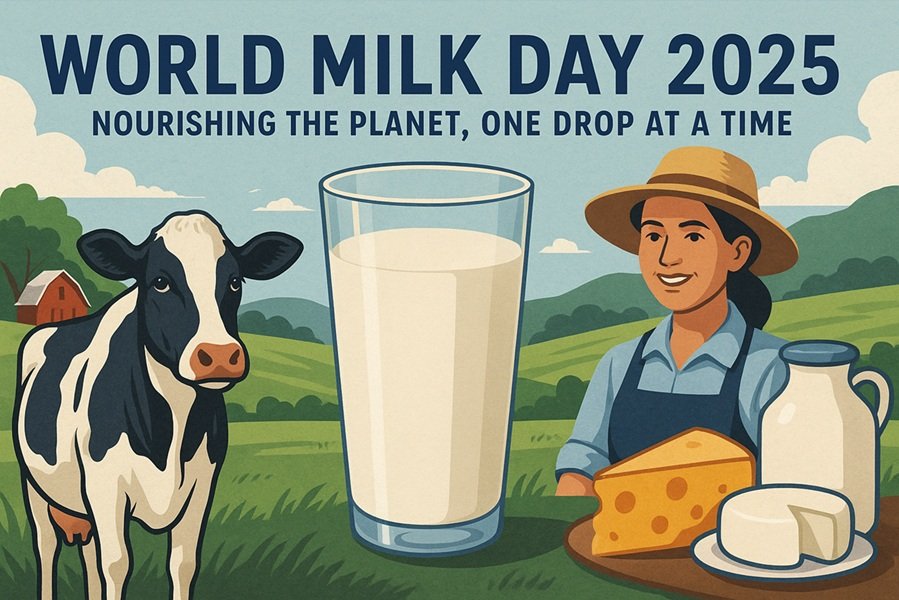
Every year on June 1st, the world raises its glass—not in celebration of a particular country, leader, or event—but in honor of something profoundly simple, yet universally cherished: milk. Since its inception by the Food and Agriculture Organization (FAO) of the United Nations in 2001, World Milk Day has grown into a global movement that highlights the enduring impact of dairy in human nutrition, economic stability, and sustainable farming.
In 2025, the theme “Let’s Celebrate the Power of Dairy” invites us to explore not only the nutritional value of milk, but also its deep-rooted cultural significance and the science-backed role it plays in building a more resilient future.
The Essence of Milk: More Than Just a Drink
Milk has been a cornerstone of human diet for millennia. From infancy to old age, milk nourishes, heals, and connects. It is not merely a beverage—it’s a complete natural food, rich in essential nutrients:
- Calcium & Phosphorus for strong bones and teeth
- High-quality proteins that build and repair body tissues
- B-complex vitamins including B12 for nervous system health
- Vitamin D, often fortified, to aid calcium absorption
- Potassium to regulate blood pressure
This powerful nutrient profile makes milk a vital dietary component, especially in developing nations where malnutrition is a persistent threat.
The Global Celebration: Unity Through Dairy
World Milk Day is now celebrated in over 100 countries, uniting farmers, scientists, educators, chefs, health experts, and consumers in a shared mission: to honor dairy’s place in a healthy, sustainable world.
From Tokyo’s milk-themed art contests to Nigeria’s interactive dairy fairs, from digital campaigns in the UK to farm tours in Argentina, the celebrations are as diverse as they are impactful. Each activity, whether offline or online, emphasizes:
- Sustainable dairy farming
- Health benefits of milk consumption
- Innovation in dairy technology
- Fair income and dignity for dairy farmers
The power of dairy, after all, lies not just in its nutrition—but also in its capacity to connect economies, cultures, and generations.
India: The Dairy Powerhouse
India, the world’s largest milk producer, plays a crucial role in the dairy landscape. This dominance is not accidental but the outcome of strategic revolutions, especially the historic White Revolution spearheaded by Dr. Verghese Kurien, the founder of AMUL.
Key Facts:
- India contributes nearly 23% of global milk production.
- Over 70 million rural households, most of them small or marginal farmers, are engaged in dairy farming.
- Milk is not just food here—it’s culture, economy, and empowerment rolled into one.
Milk in India sustains gender equity, with millions of women managing dairy cooperatives. It also provides a lifeline for rural economies, offering daily cash flow to families unlike most seasonal crops.
Dairy & Sustainability: A Delicate Balance
As we march toward sustainable food systems, dairy faces both scrutiny and opportunity. Concerns about methane emissions, resource use, and animal welfare have sparked innovation across the dairy sector.
Today’s Sustainable Dairy Practices Include:
- Use of biogas from cow dung to power farms
- Precision feeding to reduce waste and methane
- Rotational grazing for soil regeneration
- Plant-based packaging for dairy products
- Carbon footprint measurement tools for transparency
With science and policy driving innovation, the future of dairy is greener than ever.
Milk & Public Health: Building Immunity, Preventing Disease
In a world increasingly vulnerable to lifestyle disorders, milk stands as a protective ally. Regular milk consumption is linked to:
- Lower risk of osteoporosis
- Improved muscle mass in elderly
- Reduced incidence of childhood stunting
- Better hydration and electrolyte balance
In school nutrition programs, especially in developing nations, milk helps bridge the nutritional gap, ensuring children receive vital nutrients during critical growth phases.
How You Can Celebrate World Milk Day 2025
Read this: 5 Ways to Celebrate World Milk Day 2025 With Your Family
This year, individuals, schools, businesses, and governments can engage in meaningful, joyful ways to spread awareness and appreciation for dairy:
📌 Ideas for Participation:
- Milk Donation Drives: Support nutrition in underprivileged communities.
- Social Media Campaigns: Share personal milk stories using hashtags like #WorldMilkDay and #PowerOfDairy.
- Farm Visits & Webinars: Connect with local dairy farmers or attend online talks about sustainable dairy.
- Milk Recipe Contests: Explore global milk-based delicacies—lassi, paneer, cheese, custards, and more.
Whether you’re a consumer, a creator, a parent, or a policymaker—your voice adds richness to this movement.
✨ A Final Toast: Raising a Glass to the Future
World Milk Day 2025 is not just a date on the calendar. It is a global acknowledgment of milk’s silent yet profound contribution to human civilization. From rural fields to urban tables, from ancient traditions to scientific advancements, milk nourishes the body and the soul.
As we confront global health crises, climate change, and hunger, the dairy sector offers hope—not only through food—but through jobs, innovation, and community resilience.
So this June 1st, take a moment. Pour yourself a glass of milk—cold, warm, spiced, or sweetened—and remember: in that simple sip lies a legacy of care, strength, and sustainability.
Let’s celebrate milk. Let’s celebrate the people behind it. Let’s celebrate a better, nourished world.
#HappyWorldMilkDay2025
#PowerOfDairy
#DrinkToTheFuture
Read this: Complete List of International and World Days in June 2025






